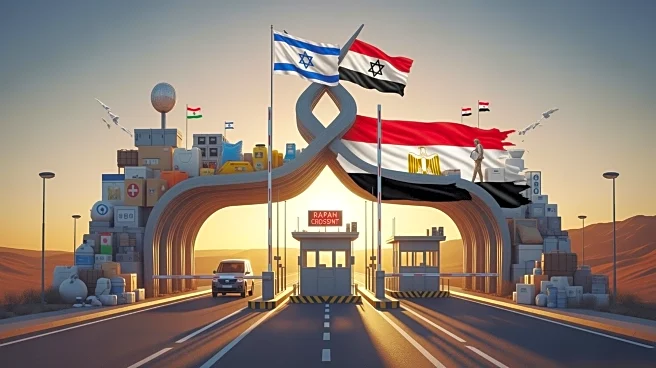What's Happening?
Israel and Egypt are preparing to reopen the Rafah border crossing, a key entry point for humanitarian aid into Gaza. The reopening is part of ongoing efforts to facilitate the movement of people and aid,
although the exact date has not been announced. The Coordination of Government Activities in the Territories (COGAT) has indicated that aid will be limited due to Hamas's slow return of hostage remains, which is seen as a violation of the ceasefire agreement. Despite these challenges, humanitarian aid continues to enter Gaza, with reports of nearly 350 trucks having already crossed into the region.
Why It's Important?
The reopening of the Rafah crossing is crucial for the delivery of humanitarian aid to Gaza, which has been severely affected by ongoing conflicts. The limitation on aid due to Hamas's actions highlights the complex dynamics of the ceasefire agreement and the challenges in ensuring compliance. The situation underscores the need for effective coordination between Israel, Egypt, and other stakeholders to address humanitarian needs while maintaining security. The flow of aid is vital for the civilian population in Gaza, which relies heavily on external support for basic necessities.
What's Next?
The next steps involve finalizing the reopening date for the Rafah crossing and ensuring that the flow of aid is not disrupted. Stakeholders, including international organizations and governments, are likely to continue negotiations to address the issues related to the ceasefire agreement and the return of hostage remains. The situation may also prompt discussions on broader strategies for stabilizing Gaza and ensuring long-term peace and security in the region.
Beyond the Headlines
The reopening of the Rafah crossing and the flow of humanitarian aid have broader implications for regional stability and international relations. The situation highlights the ongoing humanitarian crisis in Gaza and the need for sustainable solutions that address both immediate needs and long-term challenges. The involvement of multiple countries and organizations in the aid process reflects the complexity of the geopolitical landscape and the importance of collaborative efforts in conflict resolution.











